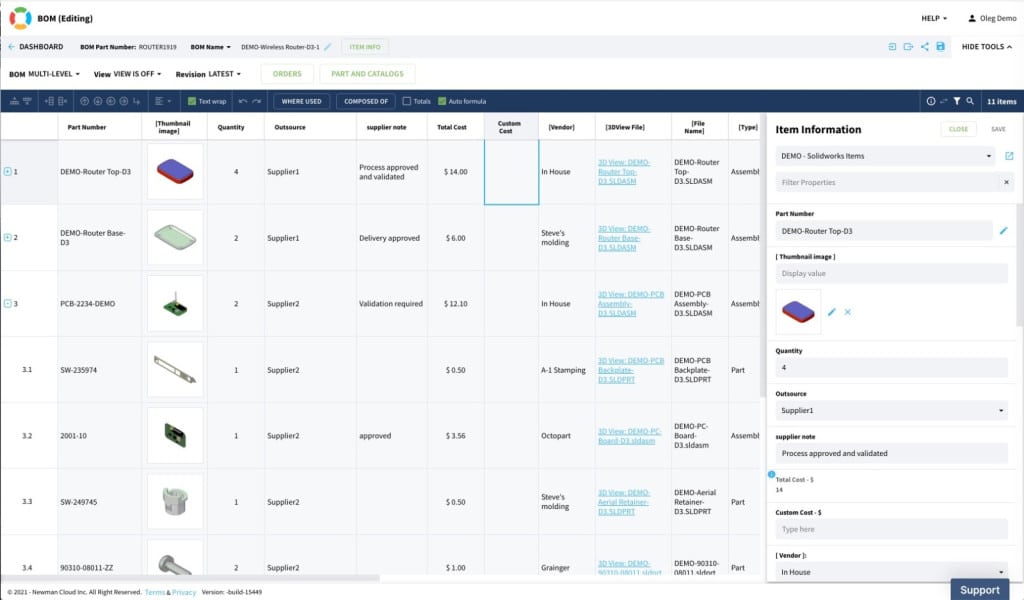Managing a Bill of Materials (BOM) in manufacturing can be likened to navigating a complex labyrinth. One key challenge is ensuring accurate documentation and record-keeping, which can be cumbersome and prone to human error. Manufacturing BOMs are not static; they evolve due to product modifications, changes in material availability, or manufacturing process tweaks. Remember, keeping track of all these changes can be a logistical nightmare.
Furthermore, businesses often grapple with managing multi-level BOMs where components are interconnected. It demands a careful balance between various sub-assemblies. Another crucial hurdle is handling multi-site coordination since modern manufacturers often operate across different geographical locations. It makes real-time data synchronization a significant concern.
Streamlining BOM management, therefore, is a necessity for efficient production. With a well-managed and streamlined BOM, manufacturers can reduce the chances of production errors caused by outdated or incorrect information. It helps save both time and resources. A streamlined BOM fosters better collaboration between different departments—design, procurement, production, and quality control—promoting a smoother workflow and faster decision-making.
An efficient BOM management system can also enable real-time data access and updates across various locations for companies with global operations, ensuring consistency and harmony in production. In essence, streamlined BOM management is a powerful backbone to underpin manufacturing operations’ efficiency, productivity, and success.
Let’s further evaluate the role of BOM management in manufacturing, along with its challenges and streamlining strategies.

Effective Manufacturing BOM Management
In this section, you’ll explore the role of effective manufacturing BOM management.
1. Ensuring Supply Chain Efficiency
Effective BOM management is the linchpin of efficient supply chain processes in manufacturing. Think of the BOM as the DNA of a product; it includes all the information about parts, materials, and assemblies to produce an item. An accurate, up-to-date BOM ensures the required materials are available at the right time and quantity. It reduces costly production delays or stoppages.
Imagine a car manufacturing plant. If the BOM management is off even by a small percentage, it could lead to shortages of crucial parts like engines or tires, disrupting the entire assembly line.
2. Optimizing Production Processes
BOM management aids in optimizing manufacturing operations. A well-managed BOM provides a clear view of manufacturing processes and enables better planning and scheduling. It helps manufacturers identify potential bottlenecks and waste areas to fine-tune their processes.
For example, in producing electronic devices like smartphones, an accurate BOM can pinpoint areas where time or resources are being wasted—perhaps due to over-ordering certain components or assembly inefficiencies—and propose alterations to streamline the production process.
3. Enhancing Product Quality and Traceability
The BOM isn’t just a list of parts; it’s also a record of revisions and updates, offering important traceability features. It is required to maintain product quality and compliance with industry standards and regulations. Suppose a component fails or a safety issue is detected. In that case, the BOM can help track down when the problem started and what products are affected.
Let’s take the aviation industry as an example; if an airplane component fails, detailed manufacturing BOM management can help quickly trace the faulty part to the specific production batch. Ultimately, it helps isolate the issue and prevent widespread problems.
4. Facilitating Collaboration and Communication
Last but not least, BOM management helps improve collaboration and communication among different teams involved in product development. Everyone relies on the BOM for information, whether in design, engineering, purchasing, manufacturing, or even after-sales service. By maintaining a single, centralized manufacturing BOM, all teams can access the same data, which reduces the possibility of miscommunication or errors due to outdated information.
Picture a large machinery manufacturing company; without effective BOM management, the design team could change a part without realizing that the manufacturing team has already ordered materials based on the old design. It prompts inefficiencies, waste, and miscommunications.

Alan B.

Mechanical Engineer
"Hands-Down the Best Platform and Partner for Fast, Quality Parts"
Jiga is the best way to get the parts you need, when you need them.
Understanding the Challenges of BOM Management
Here you understand the challenges associated with manufacturing BOM management:
Complexity of BOMs and Their Impact on Manufacturing Processes:
The growing intricacy of products, reflected in their Bill of Materials, has amplified the challenges in manufacturing processes. For instance, a typical aerospace product can have a BOM comprising over a million parts, which makes managing its manufacturing a daunting task.
Issues of Accuracy, Version Control, and Data Consistency in BOMs:
Research indicates that a high probability of BOM data errors is due to manual data input and versioning inconsistencies. These inconsistencies not only obstruct the smooth running of operations but also expressively impact product quality.
Risk of Errors, Delays, and Cost Overruns without Streamlined BOM Management:
Organizations face a substantial risk of production delays and cost overruns without efficient BOM management. In fact, studies suggest that these could inflate project budgets by up to 30%. Apart from that, such inadequacies can lead to critical errors, the correction of which may require a noteworthy investment of resources.
Strategies for Streamlining BOM Management
Now, let’s have a look at the key strategies for streamlining manufacturing BOM management.
Standardizing BOM Templates and Structures
Creating standardized BOM templates and structures is a key first step in streamlining BOM management. A standardized BOM template ensures consistency in how the organization manages and organizes bills of materials, irrespective of who creates it. A standard structure can range from deciding which information to include—including but not limited to parts name, part number, revision, and supplier—to how information is ordered and displayed.
For instance, a manufacturing company could adopt a multi-level BOM structure that separates assembly and sub-assembly items while promoting clearer communication across different teams.
Centralizing Manufacturing BOM Data
The next strategy is centralizing all BOM data. It refers to having a single, central database that stores all bills of materials and related data, accessible by all relevant personnel. In addition, it eliminates inconsistencies and discrepancies often found in decentralized data systems where different versions of the same manufacturing BOM could exist.
For example, an automotive company might have its design, manufacturing, and purchasing teams accessing and updating the same BOM in a centralized database. It ensures everyone works from the most accurate and current data as well as reduces potential errors and miscommunication.
Implementing Version Control Mechanisms
Version control mechanisms are essential for streamlining BOM management and maintaining an accurate and reliable record of changes over time. With each new iteration of a product, the BOM changes, and without a version control mechanism, it can be challenging to keep track of these changes and why they were made. It can be as simple as appending version numbers or dates to BOMs or as sophisticated as using software that tracks changes and allows for rollbacks if needed.
For instance, an electronics firm might use version control to track changes in a PCB design, which enables them to revert to an earlier design if they find issues with a newer one.

Jerry S.

Mechanical Engineer
"The holy grail of good speed, quality, and price for custom parts"
Jiga is the best way to get the parts you need, when you need them.
Leveraging Automation and Digital Tools
Finally, leveraging automation and digital tools is another key strategy for effective BOM management. Tools such as OpenBOM, Odoo, and Arena PLM can greatly enhance BOM management by automating tasks like data entry, tracking changes, and generating reports.
For instance, OpenBOM provides functionalities to automatically update BOMs whenever a design change happens in CAD software. Similarly, Odoo offers features to manage multi-level manufacturing BOMs easily for automatically calculating BOM costs based on raw material costs.
Conclusion
In conclusion, transforming your BOM management requires a proactive, technology-oriented mindset and the willingness to invest in strategies that, while challenging to implement initially, yield substantial long-term dividends. Note that efficient manufacturing BOM management doesn’t occur in a vacuum. Nevertheless, it should be considered part of a broader digital transformation strategy encompassing every aspect of manufacturing operations.
Besides, the transformation is powered by Industry 4.0 technologies, like AI and IoT, which can imbue BOM management with predictive capabilities and real-time, data-driven insights. It goes beyond just streamlining to make it a proactive, strategic tool for operational excellence. Consider AI’s potential to detect patterns in manufacturing BOM data, identify potential inefficiencies or issues before they manifest, or IoT’s role in facilitating real-time updates and traceability.
These capabilities extend the value of BOM management and enable it to pivot from mere administrative tasks to a source of competitive advantage in a digitized and competitive manufacturing landscape. As we venture into this new era, the question is not whether to streamline your BOM management but how swiftly you can adapt and excel in this dynamic terrain.
